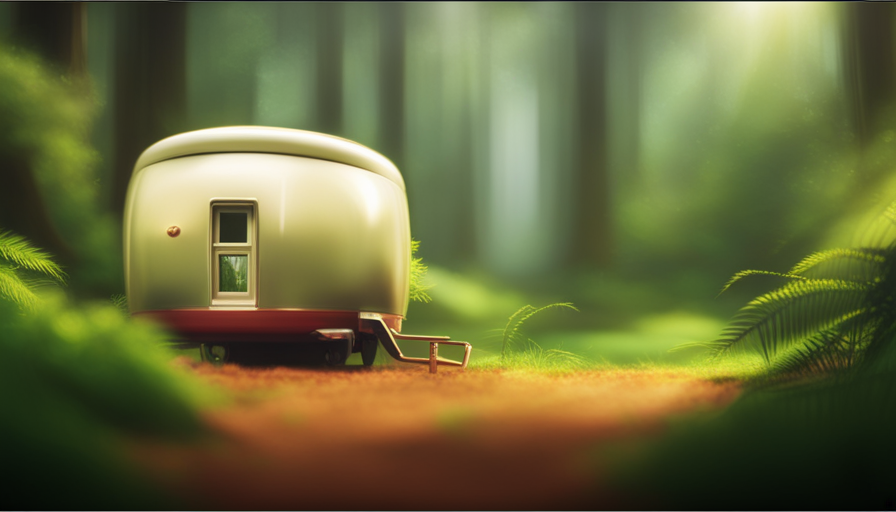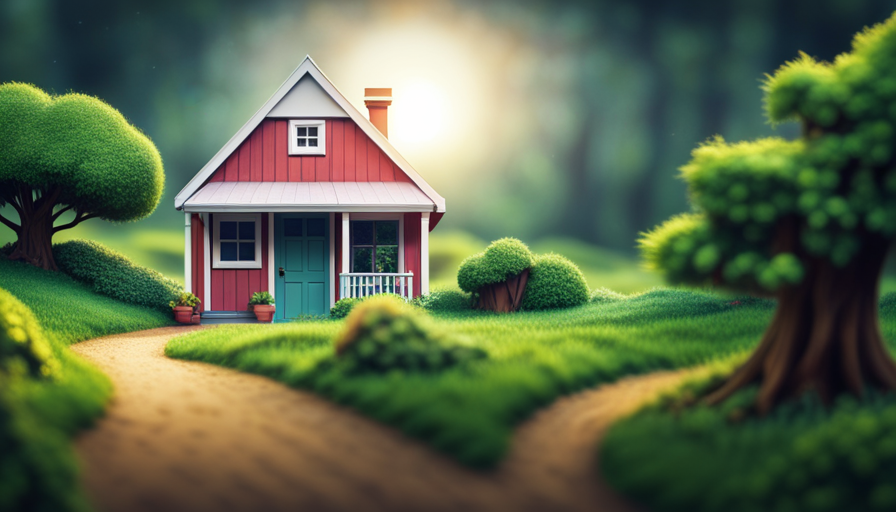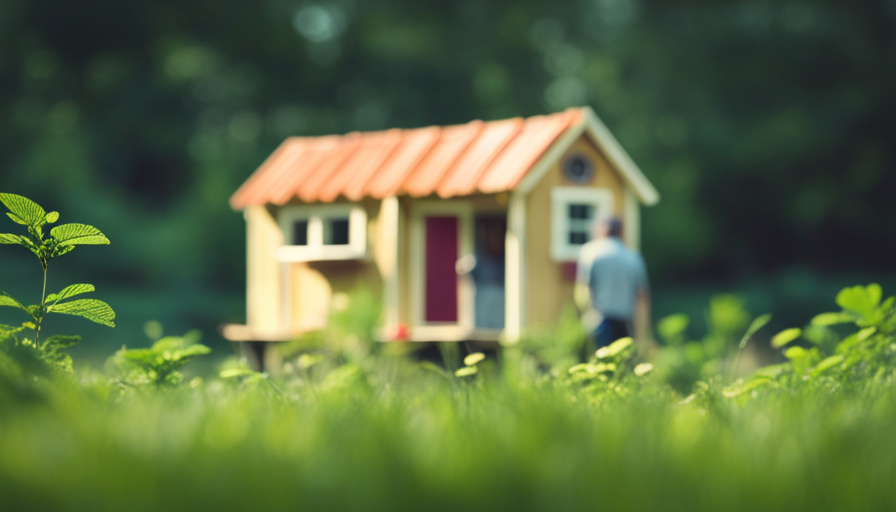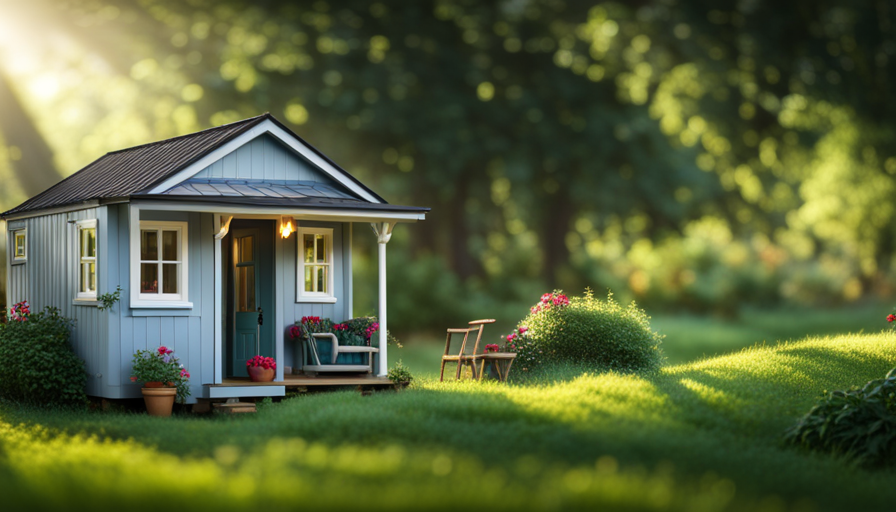When starting the journey of building a tiny house, one of the most important decisions you will make is choosing the right trailer length. This pivotal choice sets the stage for your entire tiny house project.
So, how long are most tiny house trailers? Well, let me tell you, these trailers are not just your average run-of-the-mill trailers. They are the backbone of your dream home on wheels, the vessel that will carry your hopes and aspirations to new horizons.
With my years of experience in the world of tiny house living, I’ve come to understand the intricacies of trailer lengths and their impact on your tiny house adventure. In this article, we’ll explore the factors to consider when choosing the perfect trailer length, the average lengths of tiny house trailers, and even delve into real-life examples and future trends.
So, buckle up and get ready to discover the perfect length for your tiny house journey!
Key Takeaways
- Choosing the right trailer length is crucial when building a tiny house
- Factors to consider when choosing a trailer length include weight and size restrictions, space requirements, and transportation needs
- Shorter trailers are easier to maneuver and park, but may limit living space
- Longer trailers provide more room for amenities, but may be more challenging to tow and park
Understanding the Basics of Tiny House Trailers
Did you know that one of the most important things to consider when building a tiny house is the size of the trailer it’ll be built on? Understanding the basics of tiny house trailers is crucial to ensure a successful and legal construction process.
There are several factors to consider when choosing the right trailer length for your tiny house. First and foremost, you need to be aware of the legal requirements in your area. Different states and municipalities have specific regulations regarding the dimensions of tiny house trailers. It’s important to familiarize yourself with these requirements to avoid any legal issues down the line.
Additionally, understanding the towing capacity of your vehicle is essential. The length and weight of the trailer should be within the limits of your vehicle’s capabilities to ensure safe transportation.
Another factor to consider is the size of your tiny house. The trailer length needs to accommodate the dimensions of your desired living space. It’s crucial to carefully plan the layout and design of your tiny house to ensure that it fits comfortably on the trailer.
When choosing the right trailer length for your tiny house, it’s important to consider factors such as legal requirements and the size of your living space. By taking these factors into account, you can ensure a smooth and successful construction process.
Now, let’s delve into the factors to consider when choosing the right trailer length for your tiny house.
Factors to Consider When Choosing the Right Trailer Length
When choosing the right trailer length for a tiny house, there are several factors to consider.
First, weight and size restrictions play a crucial role in determining the maximum length of the trailer.
Additionally, space requirements and design considerations are important to ensure that the tiny house has enough living space and can accommodate necessary amenities.
Lastly, mobility and transportation needs should be taken into account to ensure that the tiny house can be easily moved and transported to different locations.
Weight and Size Restrictions
Although weight and size restrictions can vary, it’s important to consider the dimensions of most tiny house trailers in order to comply with transportation regulations. When it comes to weight restrictions, it’s crucial to ensure that your tiny house trailer doesn’t exceed the maximum weight limit allowed on the roads. This includes considering the weight of the trailer itself and the weight of the tiny house that’ll be built on it.
Size limitations are equally important, as trailers that are too wide or too long may require special permits or escorts during transport. It’s essential to research and understand the specific weight and size restrictions in your area before choosing a trailer length for your tiny house. Taking these factors into account will help you avoid any legal issues and ensure a smooth transportation process.
Now, let’s move on to discussing the space requirements and design considerations for your tiny house.
Space Requirements and Design Considerations
Size and weight restrictions aside, it’s crucial to carefully consider the space requirements and design considerations for your compact dwelling. Space utilization is key when it comes to tiny house living. Optimizing layouts to maximize every inch of available space is essential. From the moment you step inside, you want to feel that your tiny house is spacious and functional. To achieve this, strategic planning is necessary. One effective way to plan your layout is by using a 3 column and 3 row table. This table can help you visualize the placement of different areas such as the living space, kitchen, bathroom, and sleeping quarters. By carefully considering how each area flows into the next, you can create a harmonious and efficient living space. Speaking of efficiency, the next section will delve into the mobility and transportation needs of tiny houses, ensuring that you can take your compact dwelling wherever you go.
Mobility and Transportation Needs
If you’re lucky enough to own a pint-sized dream home, just imagine the thrill of whisking it away to any destination with the ease of a magic carpet ride. However, before embarking on such a journey, there are a few mobility challenges to consider. One of the key factors is the size of the trailer. Here are four trailer size options to choose from:
-
16-foot trailers: These compact trailers offer excellent maneuverability and are ideal for those looking for a highly mobile tiny house.
-
20-foot trailers: Slightly larger than their 16-foot counterparts, these trailers provide a bit more living space while still being easily transportable.
-
24-foot trailers: With additional square footage, these trailers offer more room for amenities and storage, but may require a larger towing vehicle.
-
28-foot trailers: The largest of the options, these trailers provide ample space for a comfortable living experience, but require careful planning for transportation.
Considering these mobility challenges and trailer size options, it’s important to find the right balance between mobility and livability. With that in mind, let’s explore the average length of tiny house trailers.
The Average Length of Tiny House Trailers
In my experience in the tiny house movement, I’ve found that common trailer lengths range from 16 to 30 feet. Each length comes with its own set of benefits and limitations.
For example, a shorter trailer may be easier to maneuver and park, but it may also limit the amount of living space. On the other hand, a longer trailer may provide more room for amenities, but it may be more challenging to tow and find suitable parking spots.
Common Trailer Lengths in the Tiny House Movement
When you’re looking for the perfect tiny house trailer, you’ll be amazed at the range of lengths available to suit your needs.
From my experience in the tiny house movement, I’ve seen that common trailer lengths range from 16 to 30 feet.
One of the benefits of having customizable trailer options is that you can choose a length that best fits your desired living space. However, it’s important to consider that longer trailers may increase building costs due to the additional materials required.
On the other hand, shorter trailers may limit your living space and potentially restrict the layout options for your tiny house.
As we explore the benefits and limitations of different trailer lengths, you’ll gain a better understanding of which size will work best for your tiny house project.
Benefits and Limitations of Different Trailer Lengths
One of the perks of having a variety of trailer lengths to choose from is that you can tailor your tiny home to fit your exact needs and preferences. When it comes to the benefits and limitations of different trailer lengths, there are a few key factors to consider.
-
Customization options: With a longer trailer, you have more space to work with and can include additional features such as a loft or a larger kitchen. On the other hand, a shorter trailer may be more suitable for those who prefer a simpler, minimalist lifestyle.
-
Budget considerations: Longer trailers tend to be more expensive due to the additional materials needed. If you’re on a tight budget, a shorter trailer may be a more affordable option.
-
Maneuverability: Longer trailers can be more challenging to tow and navigate in tight spaces. If you plan on moving your tiny home frequently, a shorter trailer may be easier to handle.
Considering these factors, it’s important to customize your trailer length to fit your needs and preferences.
Customizing Trailer Length to Fit Your Needs
Customizing your tiny house trailer’s length allows you to tailor it perfectly to your needs, making it a unique and personalized space just for you. When it comes to customizable options, trailer length is a crucial consideration. The length you choose will determine the amount of living space you have and the amenities you can incorporate.
It’s important to think about your lifestyle and the features you want in your tiny house. Are you looking for a compact and minimalist design, or do you prefer a more spacious layout?
A shorter trailer length, such as 16 to 20 feet, may be suitable if you prioritize mobility and want to travel frequently with your tiny house. This size is easier to tow and maneuver, making it ideal for those who enjoy a nomadic lifestyle. On the other hand, if you have specific requirements for your tiny house, such as a dedicated home office or a larger kitchen, you may opt for a longer trailer length, such as 24 to 30 feet. This will provide you with more room to accommodate your desired features and ensure a comfortable living space.
Consider your needs and preferences carefully when customizing the length of your tiny house trailer. It’s essential to strike a balance between functionality and mobility. By tailoring the trailer length to fit your specific needs, you can create a tiny house that is perfect for you.
Now, let’s delve into the legal considerations and regulations for tiny house trailers.
Legal Considerations and Regulations for Tiny House Trailers
Before diving into the legal considerations and regulations for tiny house trailers, it’s crucial to understand the various codes and guidelines that govern the construction and placement of these unique dwellings.
Tiny house trailer regulations can vary depending on the jurisdiction, so it’s important to research the specific requirements in your area. One common regulation is the size restriction for tiny house trailers. Many areas have a maximum length limit for trailers, typically ranging from 20 to 30 feet. This limitation ensures that the tiny house remains mobile and can be transported safely on public roads.
Additionally, there may be restrictions on the width and height of the trailer to ensure compatibility with existing infrastructure. Understanding these regulations is essential to avoid any legal issues and ensure compliance with local laws.
By adhering to these guidelines, you can confidently design and build your tiny house trailer within the permissible size restrictions. Maximizing space and functionality in a small trailer requires careful planning and creative solutions, which we will explore in the next section.
Maximizing Space and Functionality in a Small Trailer
To make the most of your compact trailer, focus on optimizing space and functionality through strategic planning and innovative solutions. When it comes to tiny house living, maximizing storage and comfort is key. With limited square footage, every inch of space counts. To help you achieve this, I have created a table below that outlines some effective strategies for maximizing space and functionality in a small trailer.
| Strategy | Description |
|---|---|
| Utilize Vertical Space | Install shelves and cabinets that reach all the way up to the ceiling to maximize storage space. |
| Multi-functional Furniture | Invest in furniture pieces that serve multiple purposes, such as a sofa that can also be a bed. |
| Built-in Storage | Incorporate built-in storage solutions, such as under-bed drawers or hidden compartments. |
| Organizational Systems | Use storage bins, baskets, and labels to keep everything organized and easily accessible. |
By implementing these strategies, you can make the most of your tiny house trailer, ensuring that every nook and cranny is utilized effectively. Maximizing storage will help you keep your belongings organized and minimize clutter, while maximizing comfort will make your small space feel cozy and inviting.
Now that you have optimized your space and functionality, let’s move on to the next section about tips for towing and maneuvering a tiny house trailer.
Tips for Towing and Maneuvering a Tiny House Trailer
When it comes to safely navigating and towing your compact home on wheels, here are some valuable tips to keep in mind:
-
Towing: Make sure your tiny house trailer is properly hitched to your towing vehicle. Double-check all connections and ensure that the trailer is securely attached. Also, be aware of the weight limits of your towing vehicle and stay within those limits to prevent any issues on the road.
-
Parking: When parking your tiny house trailer, find a level and stable surface to park on. This will ensure that your home remains balanced and doesn’t put unnecessary strain on the structure. Use leveling blocks or jacks to adjust the height and make it even.
-
Leveling: Leveling your tiny house trailer is crucial for comfort and safety. Use a leveling tool to check the balance and adjust the height if necessary. This will prevent any tilting or sliding during your stay.
-
Maximizing Storage: In a small trailer, maximizing storage and organization is key. Utilize vertical space by installing shelves and hooks on the walls. Use storage bins and baskets to keep items organized and easily accessible.
By following these tips for towing, parking, leveling, and maximizing storage and organization in your tiny house trailer, you can ensure a smooth and enjoyable experience. In the next section, we will explore real-life examples of tiny house trailers and their lengths.
Real-Life Examples of Tiny House Trailers and Their Lengths
If you really want to see some jaw-dropping examples of real-life compact homes on wheels, check out these incredible tiny house trailers and their mind-blowing lengths! These real-life examples will surely give you some serious design inspiration for your own tiny house dreams.
One impressive example is the ‘Alpha’ tiny house trailer, measuring a whopping 24 feet in length. This tiny house on wheels isn’t just stylish but also functional, with a spacious living area, a fully equipped kitchen, and a cozy loft bedroom.
Another remarkable tiny house trailer is the ‘Escape Vista’, coming in at 21 feet long. Despite its compact size, this tiny house manages to include a full bathroom, a comfortable living area, and a well-designed kitchen.
For those looking for something even smaller, the ‘Tumbleweed Cypress’ is a charming option at just 18 feet long. Don’t let its size fool you though, as it still offers a comfortable living space, a functional kitchen, and a sleeping loft.
These real-life examples showcase the endless possibilities when it comes to designing a tiny house trailer. From compact and cozy to spacious and luxurious, there’s a tiny house trailer out there to suit every taste and lifestyle.
Now, let’s delve into the exciting future trends and innovations in tiny house trailers.
Future Trends and Innovations in Tiny House Trailers
When it comes to the future trends and innovations in tiny house trailers, there are a few key areas to focus on.
Advancements in trailer technology and materials are allowing for lighter and stronger trailers, making it easier to tow and more durable for long-term use.
Additionally, emerging design concepts and ideas are pushing the boundaries of traditional tiny house trailer designs, allowing for more creative and functional layouts.
As someone experienced in the tiny house movement, I’ve seen firsthand how these advancements are revolutionizing the industry and making tiny house living more accessible and enjoyable.
Advancements in Trailer Technology and Materials
You’ll be amazed at the incredible advancements in trailer technology and materials, making tiny house trailers more efficient and durable than ever before.
Thanks to these advancements, tiny house trailers are now built using lightweight materials that are both strong and resilient. The use of lightweight materials allows for increased mobility and ease of towing, making it easier than ever to take your tiny house on the road. These materials also contribute to improved energy efficiency, as they reduce the overall weight of the trailer, making it easier to heat and cool the space.
In addition, advancements in trailer technology have led to the development of innovative features such as solar panels, smart home technology, and energy-efficient appliances.
With all these advancements, tiny house trailers are now more sustainable and eco-friendly than ever before, paving the way for emerging design concepts and ideas in the industry.
Emerging Design Concepts and Ideas
As we’ve discussed in the previous section, advancements in trailer technology and materials have allowed for more efficient and durable tiny house trailers. Now, let’s explore some of the emerging design concepts and ideas that are shaping the world of tiny houses.
In recent years, there’s been a surge of innovative space solutions and emerging design trends in the tiny house movement. Designers are coming up with clever ways to maximize every square inch of these compact homes. They’re incorporating features such as multi-functional furniture, hidden storage compartments, and creative loft designs. These design concepts not only optimize space but also enhance the overall functionality and livability of tiny houses.
With so many exciting design possibilities, it’s important to consider these emerging trends when planning your own tiny house journey. By incorporating innovative space solutions and staying up-to-date with the latest design concepts, you can create a tiny house that perfectly suits your needs and lifestyle.
And now, let’s move on to the conclusion: finding the right trailer length for your tiny house journey.
Conclusion: Finding the Right Trailer Length for Your Tiny House Journey
To find the right trailer length for your tiny house journey, it’s important to consider the various factors that will contribute to your overall comfort and functionality. Customizing the trailer length allows you to create a space that suits your specific needs and preferences. With emerging design concepts, tiny house trailers are becoming more versatile and adaptable than ever before.
One important factor to consider when determining the length of your tiny house trailer is the size of the living area you desire. If you prefer a compact living space, a shorter trailer length may be more suitable. On the other hand, if you want a larger living area with additional amenities, a longer trailer length would be necessary.
Another consideration is the weight and towing capacity of your vehicle. It’s crucial to ensure that your vehicle is capable of safely towing the trailer length you choose. Consulting with a professional or doing thorough research can help you determine the appropriate trailer length that your vehicle can handle.
To help you visualize the different trailer lengths available, here is a table showcasing various options:
| Trailer Length | Living Area Size |
|---|---|
| 16 feet | Compact |
| 20 feet | Standard |
| 24 feet | Spacious |
Remember, finding the right trailer length for your tiny house journey is a personal decision. Take your time to consider your needs, preferences, and limitations to ensure a comfortable and enjoyable tiny house living experience.
Frequently Asked Questions
What are some legal considerations and regulations to keep in mind when it comes to tiny house trailers?
When it comes to tiny house trailers, there are important legal considerations and regulations to keep in mind.
Zoning restrictions and building codes play a crucial role in determining where and how you can park or build your tiny home. These regulations vary from place to place, making it essential to research and comply with local laws. Failure to do so can result in fines or even forced relocation.
It’s crucial to navigate these rules carefully to ensure a smooth and legal tiny house experience.
How can I customize the length of a tiny house trailer to fit my specific needs?
To customize the length of a tiny house trailer to fit your specific needs, it’s important to consider the regulations in your area. Check local building codes and zoning regulations to ensure compliance.
Additionally, towing tips are crucial for a successful build. Real-life examples can provide inspiration and guidance.
Looking ahead, future trends in tiny house living may influence your decision. By taking all these factors into account, you can create a customized tiny house trailer that meets your unique requirements.
What are some tips for towing and maneuvering a tiny house trailer?
When it comes to towing and maneuvering a tiny house trailer, there are a few key tips to keep in mind. First, make sure you have the proper towing techniques down pat, such as using a weight distribution hitch and adjusting your mirrors for optimal visibility.
Safety precautions are also crucial, like checking tire pressure and securing all loose items inside the trailer.
With experience and attention to detail, you’ll be able to navigate the road with confidence.
Can you provide some real-life examples of tiny house trailers and their lengths?
Tiny house trailer dimensions can vary depending on the specific design and needs of the owner. Popular tiny house trailer brands like Tumbleweed and Escape offer a range of sizes to choose from. For example, Tumbleweed offers trailers ranging from 16 to 28 feet in length, while Escape offers options from 19 to 25 feet.
These dimensions allow for flexibility in creating a comfortable and functional living space within a compact footprint.
Are there any future trends or innovations in tiny house trailers that we should be aware of?
Trends and innovations in tiny house trailers are constantly evolving. One trend gaining popularity is the use of eco-friendly materials and energy-efficient design. Innovations include smart home technology integration, allowing owners to control their tiny house remotely.
Another trend is the incorporation of multi-functional spaces, such as convertible furniture and hidden storage solutions. Additionally, there is a growing interest in off-grid capabilities, with advancements in solar power systems and water conservation methods.
These trends and innovations enhance the functionality and sustainability of tiny house living.
Conclusion
After delving into the world of tiny house trailers and exploring their various lengths, it’s clear that finding the perfect fit for your tiny home journey is crucial.
With legal considerations, maneuverability, and customization options in mind, the task may seem daunting. However, fear not! With a little knowledge and research, you can conquer this challenge.
Remember, the perfect trailer length can make all the difference in creating your dream tiny home. So, buckle up and get ready for an exhilarating journey into the world of tiny house living!
Hi, I’m Emma. I’m the Editor in Chief of Tiny House 43, a blog all about tiny houses. While tree houses are often associated with childhood, they can be the perfect adult retreat. They offer a cozy space to relax and unwind, surrounded by nature. And since they’re typically built on stilts or raised platforms, they offer stunning views that traditional homes simply can’t match. If you’re looking for a unique and romantic getaway, a tree house tiny house might just be the perfect option.










